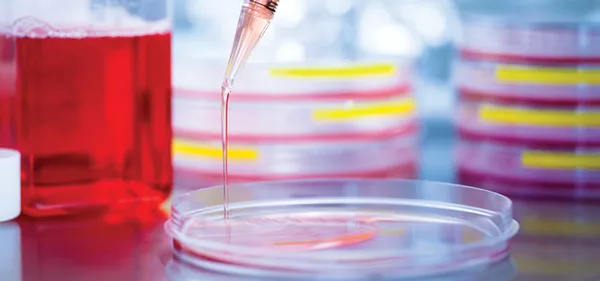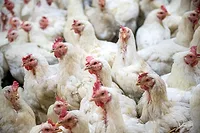Animal Cell-Culture Food Technology: A New Regulatory Frontier

The Food and Drug Administration (FDA) and U.S. Department of Agriculture Food Safety and Inspection Service (USDA-FSIS) are working together to pave the way for regulation of food produced using animal cell-culture food technology. During 2018, public discussion and press coverage of animal cell-culture food technology were increasing, and questions arose concerning which government agency would be responsible for ensuring that products coming to market were safe and accurately labeled. FDA and USDA-FSIS hosted a joint public meeting in October 2018 to explore safety and labeling issues related to this new technology. The meeting was followed by the signing of a formal agreement outlining a joint regulatory framework for overseeing the production of human food products derived from the cells of poultry and livestock using cell-culture food technology. The agreement leverages FDA’s expertise in technology used to grow cells, gained through decades overseeing biologics and various food production technologies, and USDA-FSIS’s expertise in the oversight of meat and poultry processing and labeling. In this article, we explore how the two agencies are coordinating regulatory oversight of the process and how this oversight fits with the agencies’ regulation of more traditionally produced food.
New Food on the Block
Animal cell-culture food technology is an emerging food production technique involving the controlled growth of animal cells from livestock, poultry, fish, or other animals, their subsequent differentiation into various cell types, and their collection and processing into food. This new technology has sparked substantial discussion related to regulatory oversight. In the United States, legal authority over food is primarily shared by the FDA and USDA-FSIS. In the face of a new food technology—animal cell-culture food technology—FDA and USDA-FSIS are using their distinct statutory authorities and unique areas of expertise to ensure that these new products are safe and truthfully labeled.
There has been much discussion on food safety oversight as well as debate over what to call these products. You may have heard them referred to by other names. To avoid confusion, we are going to refer to them as animal cell-culture food products. These food products begin with cells obtained from livestock, poultry, fish, or other animals. Selected cells are prepared and stored for later use in a cell bank. The food production process then starts in a controlled environment, where small amounts of cells from the cell bank first multiply many times over and then, where they differentiate into various cell types, including the muscle, fat, and connective tissue cells that make up muscle tissue. Finally, the cells are collected and processed into food products.
A Call to Action
With advances in technology and increased interest from many parties, the prospect of producing food products that incorporate cultured animal cells became a hot topic of conversation in 2018. Many companies, both foreign and domestic, are actively working on developing products using this technology. Some of these products are being designed to have the same or similar smell, texture, taste, composition, and nutritional characteristics as traditional meat and poultry products. As public discussion and press coverage of animal cell-culture technology increased, questions about regulatory authority came to the forefront of conversations.
In February of 2018, the United States Cattlemen’s Association filed a petition with USDA-FSIS regarding the labeling of cell-based products. Specifically, the petition requested that the definition of “beef” be limited to products from cattle born, raised, and harvested in the traditional manner, and that the definition of “meat” be limited to the tissue or flesh of animals that have been harvested in the traditional manner. This petition was posted publicly and directed significant attention to cellular agriculture, including over 6,000 comments from industry trade associations, consumer advocacy groups, businesses operating in the meat, poultry, and cell culture-based food product markets, and consumers.
FDA and USDA-FSIS hosted a joint public meeting in Washington, DC, on October 23 and 24, 2018, to explore safety and labeling issues related to this new technology. The meeting allowed interested stakeholders to share their thoughts on potential hazards, oversight considerations, and labeling of cell-culture food products derived from livestock and poultry. Meeting attendees included meat and poultry packers, processors, and producers; firms intending to produce food cultured from the cells of livestock, poultry, and seafood; consumer advocacy groups and consumers; and academia. FDA’s Science Board also met publicly to discuss potential hazards and nutritional considerations in the production of food derived from animal cell-culture technologies on October 22, 2018.
So, Who Makes Sure It’s Safe?
The species of the animal from which the cells originate is the starting point for determining which agency regulates these products. Under the Federal Meat Inspection Act of 1906 (FMIA), USDA-FSIS is responsible for the inspection of any meat or meat food product intended for human consumption and derived from cattle, sheep, swine, goats, or fish of the order Siluriformes (i.e., catfish). USDA-FSIS also inspects poultry and poultry products under the Poultry Products Inspection Act of 1957 (PPIA). Food products from animals not subject to inspection under the FMIA or PPIA (non-amenable species) are regulated by the FDA under the Federal Food, Drug, and Cosmetic Act of 1938 (FFDCA). It follows then that food products derived from cells of species not subject to USDA jurisdiction fit solely under the regulatory authority of FDA. However, food products made from the cells of species regulated by USDA under the FMIA and PPIA will be regulated by FDA during production (cell collection, selection, and growth) and by USDA-FSIS during processing and labeling. This arrangement resembles, in some ways, the division of jurisdiction over traditionally produced meat and poultry products. Traditionally, FDA has food safety authority over amenable livestock and poultry during on-farm production, and USDA-FSIS assumes food safety authority when they are presented for slaughter and processing. The agencies subsequently share authority over amenable livestock and poultry, with USDA-FSIS assuming primary responsibility for their regulation.
FDA has extensive experience regulating various forms of cellular technology, including substances produced by cultured cells for both food and therapeutic uses, cultured cells from non-animal sources used as foods, genetic engineering used to develop new varieties of plants, and cultured cells and tissues for therapeutic applications. This experience spans multiple centers at FDA and includes the regulation not only of food products but also of drugs and biologics under the FFDCA, some of which are produced using similar cell-culture techniques.
Similarly, USDA has experience regulating complex food processing systems, including irradiation, enzyme-based processing, and advanced meat recovery systems. USDA-FSIS conducts inspection at over 6,400 establishments, where inspectors are present during all hours of operation at livestock and poultry slaughter establishments and once per production shift at establishments that process meat and poultry products post-harvest. USDA-FSIS also has the authority to require pre-approval of labeling, including labeling claims for meat and poultry products. With this authority, USDA-FSIS can review labels for accuracy, including claims such as health claims, an “organic” claim, or a claim regarding animal raising or meat and poultry processing methods.
A Regulatory Path Forward
FDA and USDA-FSIS continued to meet following the public meeting and on March 7, 2019, signed a formal agreement outlining a joint regulatory framework for overseeing the production of human food products derived from the cells of livestock and poultry using cell-culture food technology. The agreement defines the roles and responsibilities for each agency; it leverages FDA’s expertise in technology used to grow and differentiate cells and USDA-FSIS’s expertise in the oversight of meat and poultry processing and labeling.
The bottom line of the agreement is that FDA will regulate the production process up until the point of cell harvest. At harvest, FDA and USDA will coordinate to transfer regulatory oversight from FDA to USDA-FSIS. USDA-FSIS will then assume primary regulatory oversight for the further processing and labeling of these products. And again, it’s important to remember that this framework applies only to cells extracted from animals already under USDA-FSIS jurisdiction—livestock, poultry, and fish of the order Siluriformes. Food products derived from cells extracted from other animal species not subject to USDA jurisdiction, including all other fish and shellfish, will be under the sole jurisdiction of FDA.
As described in the March 2019 formal agreement, FDA’s approach to regulating products derived from cultured animal cells will involve a thorough pre-market consultation process that includes evaluation of the production process and produced biological material, including tissue collection, cell lines and cell banks, manufacturing controls, and all components and inputs. Establishments that conduct cell banking, cell proliferation or differentiation, and cell harvest activities will be required to comply with FDA’s Current Good Manufacturing Practices and preventive control requirements for food production facilities. After a successful pre-market safety consultation, FDA will conduct routine inspections and other oversight activities at cell banks and facilities where cells are cultured, differentiated, and harvested, to ensure that potential risks are being managed and that biological material exiting the culture process is safe and not adulterated within the meaning of the FFDCA. In conducting inspections and other oversight activities, FDA will be able to draw on both the results of its pre-market consultation for the cellular material being produced by each facility and its assessment of production records maintained by the facility to ensure that all food produced there meets those standards. Should FDA uncover areas of noncompliance, it will consider enforcement action. FDA also will ensure that labeling of cell-culture products derived from animal species not subject to USDA jurisdiction is truthful and not misleading, consistent with coordinated FDA and USDA-FSIS principles for product labeling and claims.
Authority for regulatory oversight will be transferred from FDA to USDA-FSIS at the harvesting stage of the cell-culturing process (the stage at which cells are removed from a sealed growth environment and prepared for traditional food processing). As part of the formal agreement, FDA and USDA-FSIS are working to develop detailed procedures to facilitate coordination of shared regulatory oversight related to the harvest of biological material.
USDA-FSIS will carry out inspections at establishments where cells derived from livestock and poultry are harvested. These establishments will be required to have USDA grants of inspection and meet USDA-FSIS regulatory requirements for Hazard Analysis and Critical Control Points systems and sanitation. USDA-FSIS inspectors will review batch records to verify the cellular products are safe, wholesome, and not adulterated, and verify compliance with applicable USDA-FSIS regulatory requirements for any product processing. If cells are shipped to other establishments for further processing, these establishments also will be subject to USDA-FSIS inspection. USDA-FSIS inspection of cell harvest and processing will occur at a frequency of at least once per shift, the inspection frequency also required for the processing of traditional meat and poultry products. This level of verification is necessary for products to receive the USDA mark of inspection. Finally, USDA-FSIS will ensure that cell-based products are labeled truthfully and consistent with coordinated FDA and USDA-FSIS principles for product labeling and claims.
Importantly, both FDA and USDA-FSIS currently have the statutory authority to regulate animal cell-culture food technology from their respective laws (FFDCA for FDA, and FMIA and PPIA for USDA-FSIS). Both agencies have agreed to work together to identify and work through any changes needed to statutory and regulatory authorities. However, at this time, neither agency anticipates that additional legislation will be necessary for this food production technology. USDA-FSIS has publicly stated that it is interested in developing new labeling requirements for meat and poultry products produced using this process. USDA-FSIS is committed to a public process for developing these requirements, which likely will involve rulemaking.
The joint FDA and USDA-FSIS public meeting also served to identify key areas where coordination between both agencies will be necessary to inform future decision making; three FDA and USDA-FSIS work groups have been formed as a result. The first work group established, led by FDA, is a pre-market food safety assessment group tasked with developing the overall pre-market consultation process. The second work group concerns transfer of jurisdiction and will develop the procedures for transferring inspection from FDA to USDA-FSIS at the cell harvest stage; FDA and USDA-FSIS are co-leads for this work group. The final work group is the labeling group, led by USDA-FSIS, which will develop coordinated principles for product labeling and claims to ensure consistency and transparency.
Bringing the Production Process into Focus
Although animal cell-culture food technology products are in various phases of development, both FDA and USDA-FSIS are engaging with industry to learn about the specific processes and technologies that companies are using to develop products. The agencies recognize that some details of this technology might be considered proprietary, but we encourage industry to share information with regulators sooner rather than later. The more we know about the finer points of the processes and technologies now, the better we will be able to design regulatory processes that work with each technology, preventing regulatory delays down the road.
We expect that many characteristics of the products that can be produced by these processes and technologies will vary, such as the composition, nutritional content, shelf life, and functionality. We believe that many of these characteristics will need to be reflected through the labeling of these products, which may require careful evaluation and an iterative, data-driven dialogue with industry. Given these considerations, we also believe that these discussions with industry should begin soon to prevent unnecessary delays once companies are ready to bring products to market.
Matthew Michael is the Director of the Issuances Staff at USDA-FSIS. Jeremiah Fasano, Ph.D., is a senior policy advisor in the Office of Food Additive Safety's Division of Science and Technology at the Center for Food Safety and Applied Nutrition, FDA.
Looking for quick answers on food safety topics?
Try Ask FSM, our new smart AI search tool.
Ask FSM →








